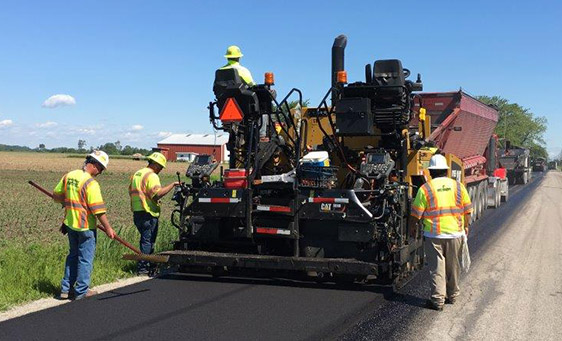Opening the Tricks of Hot Mix Asphalt Technology
Exploring the midsts of hot mix asphalt modern technology uncovers a globe where thorough processes and precise solutions merge to form our roads and infrastructure. The blend of binders, fillers, and accumulations isn't just a construction task but a tactical orchestration of durability and effectiveness. As we peer right into the elaborate dancing of parts, a tapestry of strength and sustainability unravels. But what exists beneath this surface of asphaltic mastery, and what secrets wait to be introduced in the realm of leading advancements?
Importance of Warm Mix Asphalt
Warm Mix Asphalt plays a critical role in modern facilities growth because of its durability and cost-effectiveness. As the most commonly used paving material for roadways, highways, and parking area, Warm Mix Asphalt supplies a range of advantages that add to its importance in construction tasks. One essential advantage is its capacity to hold up against rush hour loads and extreme weather, offering a reliable and resilient surface area for transportation networks. Furthermore, Hot Mix Asphalt is economical in both preliminary building and construction and long-lasting upkeep, making it a preferred option for numerous facilities projects.
The resilience of Hot Mix Asphalt stems from its composition, which consists of aggregates, binder, and filler materials that are carefully selected and mixed to fulfill particular efficiency demands. Generally, the significance of Hot Mix Asphalt in framework growth can not be understated, as it continues to be a foundation of modern construction practices.
Elements of Asphalt Mixes
The make-up of asphalt blends is composed of thoroughly chosen aggregates, binder, and filler products that are important for attaining certain efficiency needs. Accumulations are the main part of asphalt blends, supplying stamina and security. The binder, commonly bitumen or asphalt concrete, holds the aggregates with each other and supplies versatility and durability to the mix.
The mix and proportion of these components play a significant role in determining the quality and performance of the asphalt mix. Designers very carefully design the mix to meet certain demands, taking into consideration factors like website traffic volume, environment problems, and pavement life-span. Appropriate choice and balancing of aggregates, binder, and fillers are vital for developing durable, long-lasting asphalt sidewalks.
Combining and Manufacturing Methods

Once the accumulations are chosen, the binder, typically asphalt concrete, is contributed to bind the products with each other. The binder's high quality and quantity dramatically impact the mix's resistance, toughness, and versatility to environmental variables. In addition, fillers like hydrated lime or Portland cement may be included to improve certain characteristics of the asphalt mix, such as its workability or dampness resistance.
Throughout manufacturing, the aggregates and binder are heated, typically between 250-325 ° F(121-163 ° C ), to assist in blending and ensure correct finishing of the aggregates. The mixing process should be detailed to achieve an uniform mixture that advertises the desired performance characteristics of the asphalt. Different techniques, such as batch blending or drum blending, are utilized to accomplish top notch and constant asphalt mixes for construction tasks.
Variables Impacting Asphalt Efficiency
Factors affecting asphalt performance encompass an array of variables that influence the resilience, longevity, and overall high quality of asphalt sidewalks. One vital variable is the top quality of products utilized in the asphalt mix.

Style considerations, such as sidewalk thickness and water drainage, are necessary in guaranteeing the lasting efficiency of the asphalt sidewalk. By thoroughly thinking about these aspects, engineers and service providers can optimize asphalt performance and enhance the solution life of pavements.
Sustainable Practices in Asphalt Innovation

Furthermore, the growth of warm-mix asphalt (WMA) technologies has gained grip in the last few years. WMA enables the production and positioning of asphalt mixes at reduced temperature levels contrasted to conventional hot-mix asphalt, causing lowered energy usage and greenhouse gas emissions. The usage of permeable asphalt blends can aid alleviate stormwater runoff problems by allowing water to penetrate with the sidewalk and right into the ground, promoting natural water filtering and reenergize processes. By executing these lasting techniques, the asphalt industry can add to building a much more eco friendly and resistant facilities network.
Final Thought
Finally, warm mix asphalt technology hot mix asphalt plays a critical function in contemporary infrastructure advancement due to its sturdiness and cost-effectiveness. By very carefully stabilizing components, employing proper mixing methods, and taking into consideration different aspects, designers can produce high-grade asphalt blends that stand up to heavy web traffic tons and extreme weather condition conditions. Accepting sustainable methods, such as making use of recycled materials and warm-mix modern technologies, better enhances the ecological friendliness of asphalt modern technology.
Blending and production strategies in hot mix asphalt innovation involve the accurate mix and handling of aggregates, binder, and fillers to create a high-performance and sturdy asphalt mix.Aspects affecting asphalt efficiency include a range of variables that affect the durability, longevity, and general quality of asphalt pavements. Sustainable methods in asphalt modern technology incorporate numerous initiatives intended at minimizing the ecological impact of asphalt production and paving processes. By incorporating reclaimed asphalt sidewalk (RAP) and recycled asphalt roof shingles (RAS) right into new asphalt blends, the sector can dramatically minimize the usage of raw products and power, while likewise reducing landfill waste.
WMA allows for the manufacturing and placement of asphalt blends at reduced temperature levels compared to typical hot-mix asphalt, resulting in minimized power usage and greenhouse gas exhausts.